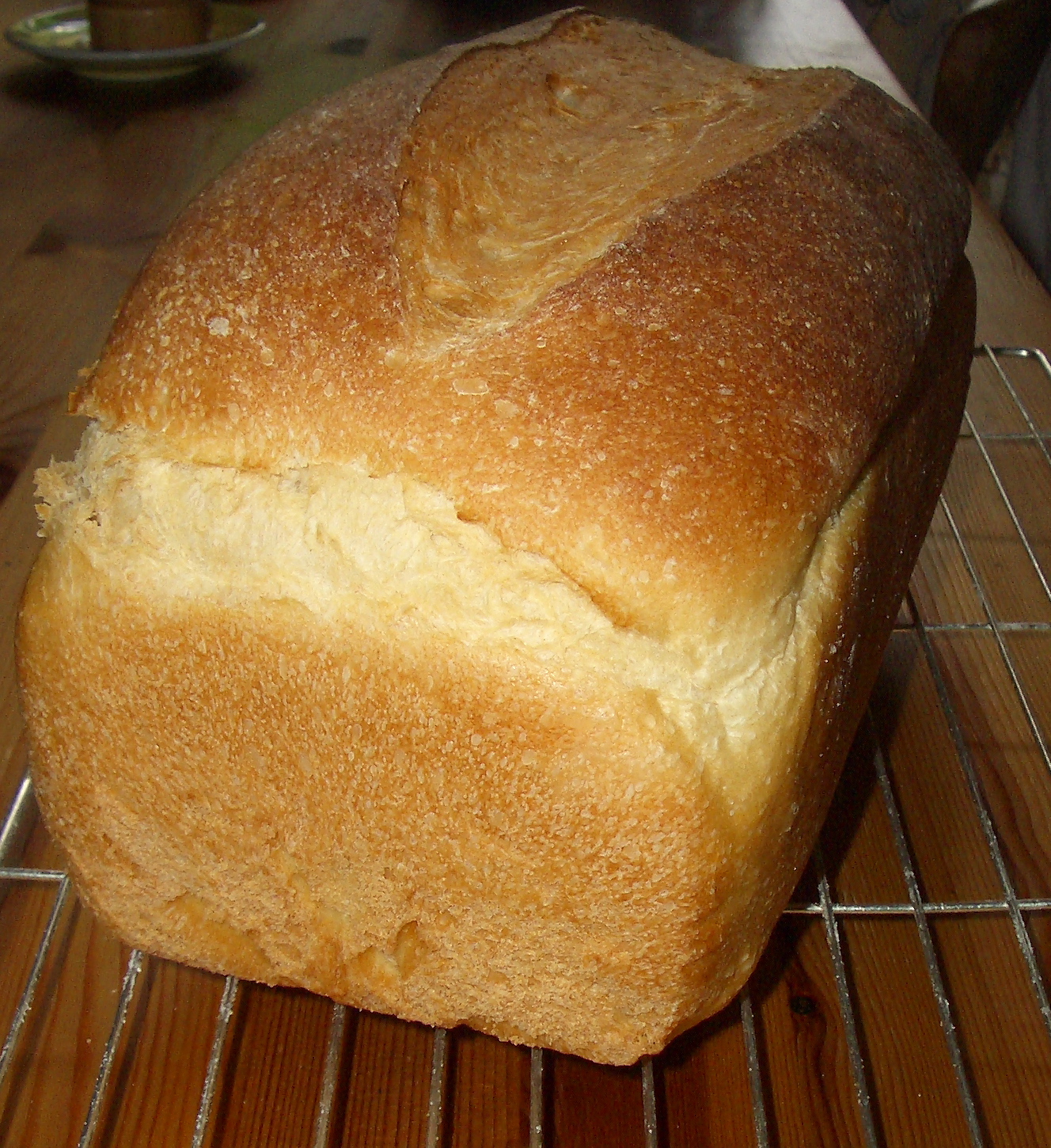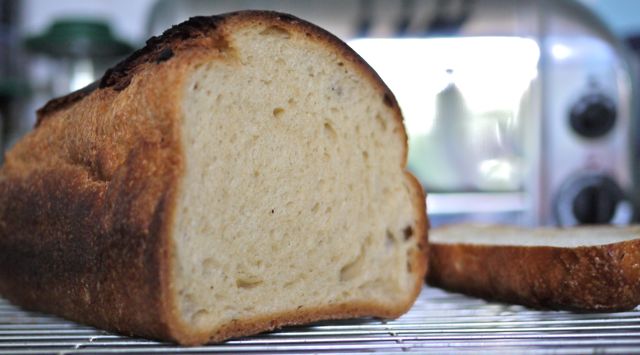I know I’ve been gone a while but hey now I’m back! First post after 5 weeks is this Fresh From the Oven Challenge that I hosted. I am going to do a post about going AWOL so watch out for that coming up in the next few days, but here to whet you appetite for upcoming posts is some delicious bread I can highly recommend.

Although I’ve made this loaf a lot of the past few months either white or a 50:50 white-wholemeal mix I still thought I’d do one especially for the challenge. Unfortunately the day I was baking it I was in the the final stages of web project and wasn’t really concentrating properly. It was also quite a cool day so the 2nd rise seemed to be taking for ever so I put it in the oven regardless (it was no where near the top of the tin!) . I got okay oven spring but in the first 10 minutes of cooking I lost track of time as the client called to sign off the website ready for go live and to say how pleased they were. Result a rather dense chewy loaf, with a very crusty crust and a borderline burnt top. Still tasted better than anything you get in most bakers….

Here’s what I said to the Fresh from the Oven group when I set the challenge:
I’ve done lots of um-ing and ah-ing about what to pick for the challenge, I wanted something where I could show you the kneading technique I learnt from the Dan Lepard course I went on, something that seemed specifically English and something not so time consuming that you all decided not to participate. Crumpets and pikelets were out on the basis they don’t require kneading, sourdough on the basis that you might not all have starter so that would be a week of building one. Stotties were almost in but the recipe I found had potato in and that’s not how I remember them. Staffordshire oatcakes popped up but they don’t have to be kneaded either and so on and so forth.
At last I decided to keep it simple but still English. There is lots of talk of how bad English bread is (and it is when its made on an industrial scale using the Chorleywood process) but then everyone decides to ignore all thought of English bread and fall into the arms of French and Italian and other baking heritages. I love all these other breads but I also love a good old fashioned properly made tin loaf that is soft but slightly chewy, has a nice medium crust, that toasts brilliantly and makes a mean sandwich. The secret of course is in using milk for part of the liquid this gives a softness that’s just right without making the loaf a full on slightly sweet milk loaf (although when I found this on the Lakeland site I did nearly decide to do milk loaf).
If you don’t fancy doing a tin loaf then perhaps you can take part by using the kneading technique for your favourite loaf because it seems to work for everything from sourdough to rolls to pizza base and more.
First the technique:
Dan Lepard says he developed this when he was working full time in commercial kitchens (that made artisan hand kneaded bread) because there wasn’t time for full 10 minute knead of all the different bread batches so he switched to short kneads spaced out and found it works just as well, part of the development of a good gluten structure is dependent on the time elapsed not the vigorous kneading. I liked the idea because I’d not been getting good textures with either a machine or a normal hand knead. I am now a wholesale convert.
Note:
You must use oil not flour on the kneading surface and your hands. Something like vegetable oil is good.
The dough must be quite sticky and soft to start with. It will firm up when kneaded and as time progresses.
Steps:
- Once you have soft sticky dough leave it covered in the bowl for 10 minutes.
- Now oil your kneading surface and hands and tip the dough out.
- Knead for about 12 seconds by folding in the edges to the centre, a bit like shaping a round loaf, rotate the dough as you go.
- Flip the dough over, leave it on the surface and cover with a cloth. Wash out the bowl and then oil it lightly. Put the dough back in the bowl and cover.
- Leave for 10-15 minutes and then do another 12 second knead. You will notice the dough is already less sticky and firmer.
- Leave for 20 -30 mins and repeat the fast knead. You are aiming to have kneaded the dough 3 times in the first hour.
- Leave covered to rise until at least 50% larger but not more than double in size (kneading once per hour if it takes more than hour to increase in size).
- Tip out onto the oil surface and press the air out of the dough using the tips of your fingers so its square-ish in shape. Repeat the fast knead process (or fold in to thirds then rotate through 90, flatten again and fold into 3rds again).
- Shape the dough as required for the particular loaf you are making. Put it in a tin, or supported in a floured cloth in a bowl.
- Leave to rise until at least 50% larger and preferably almost double in size.
- Slash top and bake as per your recipe.
White Tin Loaf (based on Dan Lepard’s Quick White Loaf, p63 of the Handmade Loaf)
2lb loaf tin greased and floured or lined with baking parchment (no need to line the short ends just oil them).
Oven to be pre-heated to its maximum setting (R10/250C) and with a tray of water in the bottom to create steam.
Ingredients:
200g semi skimmed milk at room temp (Dan uses whole milk but semi skimmed seems to work fine)
150g water at room temp (remember 1g = 1ml but its easier to be accurate weighing fluids)
1 tsp fast action yeast (or 2 tsp fresh yeast crumbled)
200g plain white flour
300g strong white bread flour
1 ½ tsp fine sea salt
Method:
Mix the flours and salt together in a bowl.
Mix the water and milk together in a separate bowl and whisk in the yeast.
Add the liquid to the flour and mix with the fingers of one hand to a soft sticky rough dough. You may need to add a little more liquid do this a teaspoon at a time until you have a soft sticky dough.
Follow the kneading instructions above.
The first rise will probably take about an hour from the last knead.
To shape for a tin loaf, flatten the dough to a square about the same width as your tin. Roll the dough into a cylinder and press the seam firmly, fold under the two short ends and place in the tin seam side down.
Allow to rise (covered) to 1 ½ to 2 times volume i.e. to the top of the tin.
Slash the top of the loaf along it length and put it straight into the oven for 10 minutes at maximum temperature. After 10 minutes check how it’s browning and drop the temperature as follows (these baking guidelines are from the River Cottage Bread Book):
R6/200C if the crust is pale
R4/180C if crust is noticeably browning
R3/170C if crust is browning quickly
And cook for a further 40-50 minutes.
I usually check again part way through this time and either adjust temperature again or cover the top with foil if it’s brown enough. Also note that with a traditional gas oven (i.e. one without a fan) the top may brown far too quickly on the side near the heat at the initial temperature so you might want to start at a lower setting of R8/9 for the first 10 minutes. Adapt the setting for what you know about your oven and how things usually bake.
When it’s cooked turn it out of the tin and allow to cool.
Then when it’s cooled cut a big huge doorstop of a slice, toast it and slather with lashing of butter. Yum.
The recipe also works well with a mix of 50:50 wholemeal and white bread flours. You’ll probably need 2-3 tbps extra water.

Sometimes you just can’t beat a good old fashioned loaf I agree! Good to see you back.
.-= Helen´s last blog ..A Swift Lunch at Needoo Grill =-.
Thanks so much for this challenge piece, I made this tin loaf yesterday and now there is barely any left. I like this technique for kneading bread but it felt like maybe took longer than my previous kneading technique. In saying that though it definitely produced better results, so well worth the extra investment!
.-= Lauren´s last blog ..White Tin Loaf – Fresh from the Oven =-.
Hello, I accidently come across your site whilst browsing around Google as I’m looking for some information on wall ovens!. I think it’s a very interesting site so I have bookmarked you and I intend to return soon to enjoy a more indepth read when I’ll more free time.
Thank you again for hosting this months challenge. Hope this post is the first of many more to come!
.-= Claire´s last blog ..Fresh from the oven – White tin loaf =-.
Linda, that is a stunning loaf. Your bread making is very impressive.
.-= Jan´s last blog ..The Crown Prince and the naked pumpkin =-.
Nothing like a good homebaked piece of bread – and this looks marvelous Linda
Intrigued by Dan Lepard’s method, will have to try that…
.-= scandilicious´s last blog ..Recipe from the Blaggers’ Banquet – a sumptuous chocolate fondant from Trish Deseine =-.
I was reading about this kneading method last night! I must try it soon. Thanks for the explanation. (This was the FFTO challenge the month before I joined, so I can see that I missed out!)
This looks both delicious and relatively simple. Hopefully – if I can find my bread tin – going to give it a try on Sunday and see how it goes!